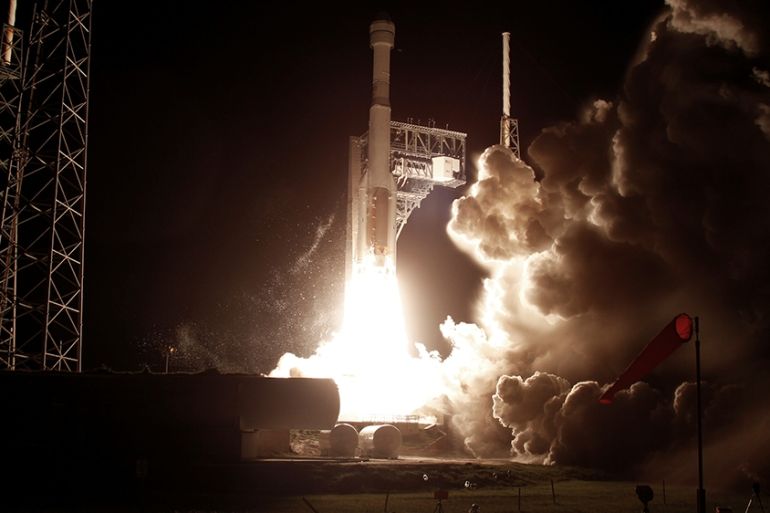Starliner stays grounded as Boeing and NASA investigate further
Preliminary findings on the orbital flight test failures are in, but questions remain unanswered.

NASA and Boeing Co revealed on Friday the preliminary results of an ongoing joint investigation into a failed test in December involving the aerospace giant’s Starliner spacecraft.
Starliner, which is designed to carry humans into space, failed to rendezvous with the International Space Station (ISS) during an orbital flight test (OFT) late last year, triggering a probe into primary issues that occurred during the test, including “specific concerns” about software anomalies that could have been a factor.
Keep reading
list of 3 itemsSpaceX test succeeds; now plans to launch two astronauts to space
Boeing Starliner is back on Earth
NASA said in a statement that it was the ground-based flight control team’s intervention that prevented Starliner – which is already years behind schedule and hundreds of millions of dollars over budget – from being lost.
On Friday, NASA Administrator Jim Bridenstine told reporters that the joint investigation team is expected to conclude its probe and make corrective recommendations to both Boeing and NASA, the United States space agency, by the end of February.
“Clearly we are going to continue to learn more in the weeks ahead,” Bridenstine said. “It’s also true that we do think that the OFT flight had a lot of anomalies.”
According to the statement, NASA will also conduct a separate “comprehensive safety review” that will include interviews with individual employees, from engineers to senior managers, at multiple sites. The review examining workplace culture is being added to NASA’s contract with Boeing, and must be completed before the company can launch Starliner again.
Douglas Loverro, the associate administrator of NASA’s Human Exploration and Operations Mission Directorate, said the review was necessary to find the root cause of what investigators believe is a greater problem.
“To put it bluntly the issue that we’re dealing with is we have numerous process [inconsistencies] in the software design, development and test cycle for Starliner,” Loverro said, adding that the “issues you all know about are indicators of the software problems, but they are likely only symptoms of the real problem.”
Boeing Co’s Starliner is part of NASA Commercial Crew Program, which supports the US private sector in developing multiple commercially-operated crewed launch systems to provide the space agency with “reliable and cost-effective access to and from the International Space Station”.
Boeing Co’s direct Commercial Crew competitor, Elon Musk’s SpaceX, conducted a successful orbital flight test that saw its Crew Dragon craft dock at the ISS last March.
Last month, SpaceX successfully conducted a successful “in-flight abort” test – the final milestone before astronauts launch on its vehicle.
When Boeing Co tested its Starliner launch system last December, faulty software caused the uncrewed capsule’s thrusters to skip an orbit-raising burn, and then use a large number of short fuel burns at the wrong time. At that very moment, the flight control team was prevented from communicating with the spacecraft, and therefore lost control over it momentarily.
As a result, the spacecraft reached the wrong orbit without enough fuel. Boeing could not complete the test’s primary objective of docking Starliner with the ISS and the mission was cut short, from seven days to two.
What the preliminary findings of the investigation do not explain is why the on-the-ground flight control team was unable to maintain uninterrupted communication, and therefore command and control of the Starliner craft at all times. The statement said that the communications issue is still under investigation.
Both NASA and Boeing would not commit to whether another orbital flight test would be required, or when the Starliner may launch again.
Problems with Boeing Co’s Starliner come at a time when the US Congress is looking to diminish the role that commercial space transportation providers play in NASA’s human exploration and operations programmes. In a bill introduced last week, legislators took aim at a key policy of the administration of US President Donald Trump: buying commercially provided and maintained lunar landing services as a foundation for a human Mars mission in the 2030s.
If the legislation becomes law, Beoing could become NASA’s primary contractor, not just for rockets, but also for human landing systems for missions to the moon, placing competitors such as SpaceX and Jeff Bezos’s Blue Origin on the back foot.
On Friday, the Wall Street Journal reported that the Trump administration was seeking to increase NASA’s 2021 budget by 12 percent to $25.2bn with most of the additional funds targeted at sending US astronauts back to the moon by 2024. The yet-to-be-released budget request reportedly includes $3bn for human landing systems, which the administration wants multiple commercial interests to develop, own and operate.
Anticipating that NASA may require another orbital flight test, Boeing CEO Dave Calhoun told investors in his latest earnings call on January 29 that the company was taking a “$410 million pre-tax charge to provision for the additional uncrewed mission for the Commercial Crew programme as well as several performance items.”